Hua Han
Shenzhen Institute of Advanced Technology, Chinese Academy of Sciences, Shenzhen, China, University of Chinese Academy of Sciences, Beijing, China
From Diffusion to Resolution: Leveraging 2D Diffusion Models for 3D Super-Resolution Task
Nov 25, 2024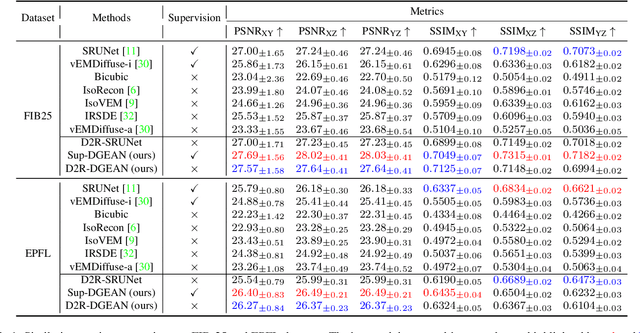
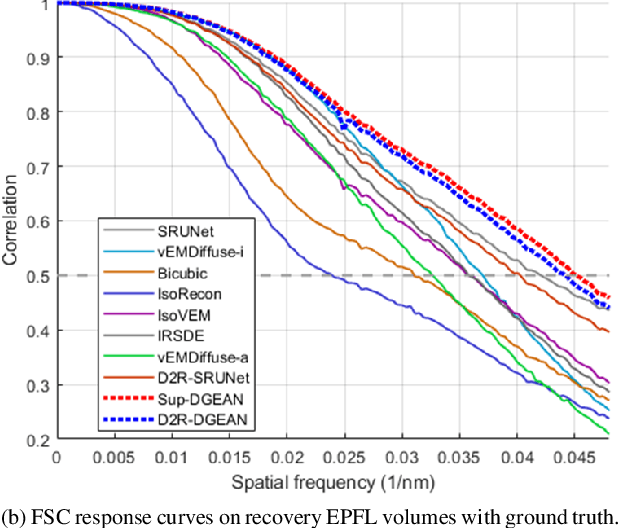
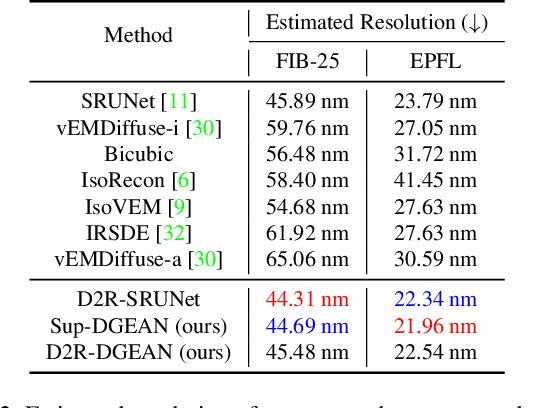
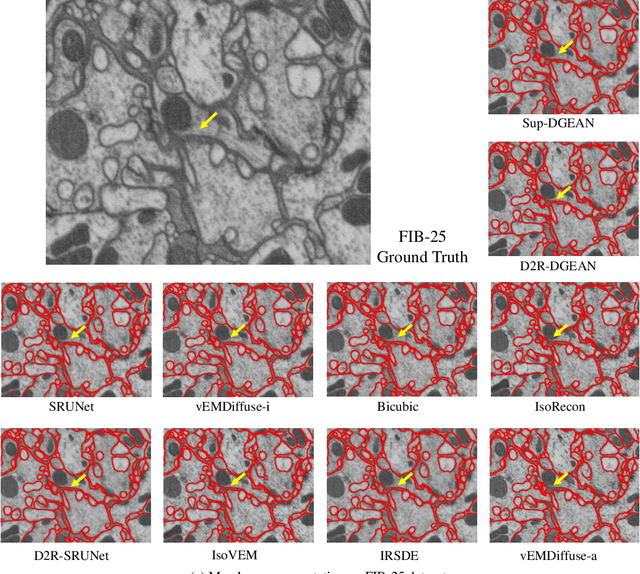
Abstract:Diffusion models have recently emerged as a powerful technique in image generation, especially for image super-resolution tasks. While 2D diffusion models significantly enhance the resolution of individual images, existing diffusion-based methods for 3D volume super-resolution often struggle with structure discontinuities in axial direction and high sampling costs. In this work, we present a novel approach that leverages the 2D diffusion model and lateral continuity within the volume to enhance 3D volume electron microscopy (vEM) super-resolution. We first simulate lateral degradation with slices in the XY plane and train a 2D diffusion model to learn how to restore the degraded slices. The model is then applied slice-by-slice in the lateral direction of low-resolution volume, recovering slices while preserving inherent lateral continuity. Following this, a high-frequency-aware 3D super-resolution network is trained on the recovery lateral slice sequences to learn spatial feature transformation across slices. Finally, the network is applied to infer high-resolution volumes in the axial direction, enabling 3D super-resolution. We validate our approach through comprehensive evaluations, including image similarity assessments, resolution analysis, and performance on downstream tasks. Our results on two publicly available focused ion beam scanning electron microscopy (FIB-SEM) datasets demonstrate the robustness and practical applicability of our framework for 3D volume super-resolution.
Modality Exchange Network for Retinogeniculate Visual Pathway Segmentation
Jan 03, 2024Abstract:Accurate segmentation of the retinogeniculate visual pathway (RGVP) aids in the diagnosis and treatment of visual disorders by identifying disruptions or abnormalities within the pathway. However, the complex anatomical structure and connectivity of RGVP make it challenging to achieve accurate segmentation. In this study, we propose a novel Modality Exchange Network (ME-Net) that effectively utilizes multi-modal magnetic resonance (MR) imaging information to enhance RGVP segmentation. Our ME-Net has two main contributions. Firstly, we introduce an effective multi-modal soft-exchange technique. Specifically, we design a channel and spatially mixed attention module to exchange modality information between T1-weighted and fractional anisotropy MR images. Secondly, we propose a cross-fusion module that further enhances the fusion of information between the two modalities. Experimental results demonstrate that our method outperforms existing state-of-the-art approaches in terms of RGVP segmentation performance.
LESEN: Label-Efficient deep learning for Multi-parametric MRI-based Visual Pathway Segmentation
Jan 03, 2024Abstract:Recent research has shown the potential of deep learning in multi-parametric MRI-based visual pathway (VP) segmentation. However, obtaining labeled data for training is laborious and time-consuming. Therefore, it is crucial to develop effective algorithms in situations with limited labeled samples. In this work, we propose a label-efficient deep learning method with self-ensembling (LESEN). LESEN incorporates supervised and unsupervised losses, enabling the student and teacher models to mutually learn from each other, forming a self-ensembling mean teacher framework. Additionally, we introduce a reliable unlabeled sample selection (RUSS) mechanism to further enhance LESEN's effectiveness. Our experiments on the human connectome project (HCP) dataset demonstrate the superior performance of our method when compared to state-of-the-art techniques, advancing multimodal VP segmentation for comprehensive analysis in clinical and research settings. The implementation code will be available at: https://github.com/aldiak/Semi-Supervised-Multimodal-Visual-Pathway- Delineation.
Blind2Sound: Self-Supervised Image Denoising without Residual Noise
Mar 14, 2023



Abstract:Self-supervised blind denoising for Poisson-Gaussian noise remains a challenging task. Pseudo-supervised pairs constructed from single noisy images re-corrupt the signal and degrade the performance. The visible blindspots solve the information loss in masked inputs. However, without explicitly noise sensing, mean square error as an objective function cannot adjust denoising intensities for dynamic noise levels, leading to noticeable residual noise. In this paper, we propose Blind2Sound, a simple yet effective approach to overcome residual noise in denoised images. The proposed adaptive re-visible loss senses noise levels and performs personalized denoising without noise residues while retaining the signal lossless. The theoretical analysis of intermediate medium gradients guarantees stable training, while the Cramer Gaussian loss acts as a regularization to facilitate the accurate perception of noise levels and improve the performance of the denoiser. Experiments on synthetic and real-world datasets show the superior performance of our method, especially for single-channel images.
Uncertainty-Aware Multi-Parametric Magnetic Resonance Image Information Fusion for 3D Object Segmentation
Nov 16, 2022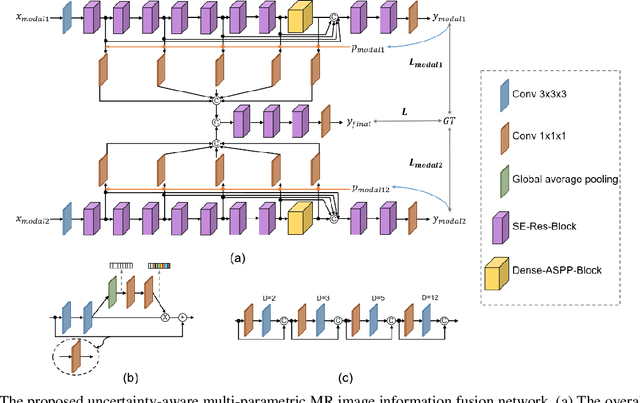
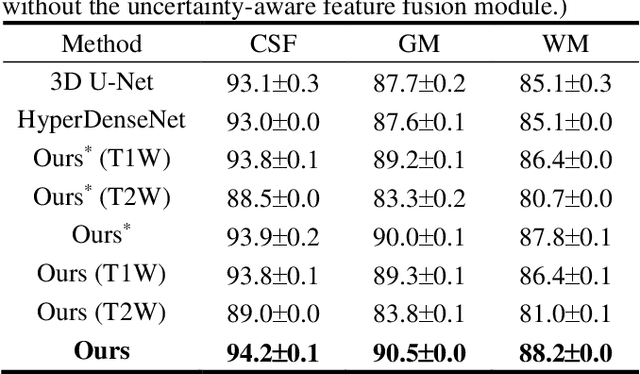
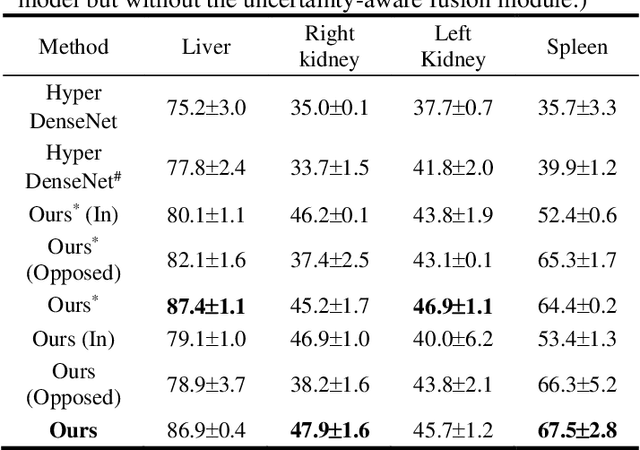
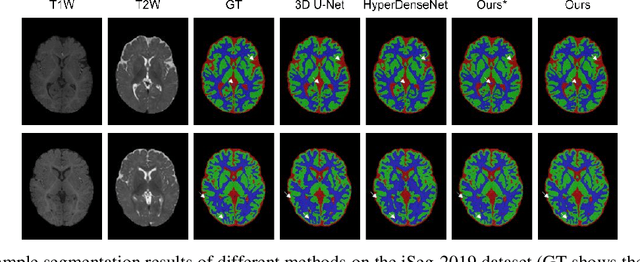
Abstract:Multi-parametric magnetic resonance (MR) imaging is an indispensable tool in the clinic. Consequently, automatic volume-of-interest segmentation based on multi-parametric MR imaging is crucial for computer-aided disease diagnosis, treatment planning, and prognosis monitoring. Despite the extensive studies conducted in deep learning-based medical image analysis, further investigations are still required to effectively exploit the information provided by different imaging parameters. How to fuse the information is a key question in this field. Here, we propose an uncertainty-aware multi-parametric MR image feature fusion method to fully exploit the information for enhanced 3D image segmentation. Uncertainties in the independent predictions of individual modalities are utilized to guide the fusion of multi-modal image features. Extensive experiments on two datasets, one for brain tissue segmentation and the other for abdominal multi-organ segmentation, have been conducted, and our proposed method achieves better segmentation performance when compared to existing models.
Blind2Unblind: Self-Supervised Image Denoising with Visible Blind Spots
Mar 15, 2022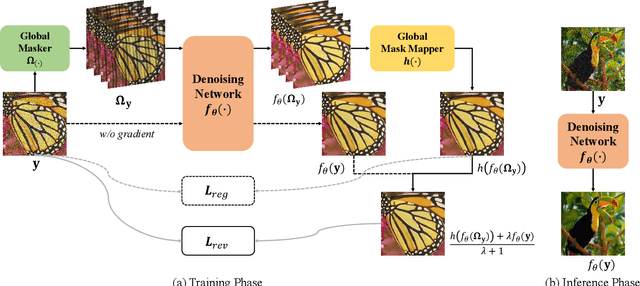
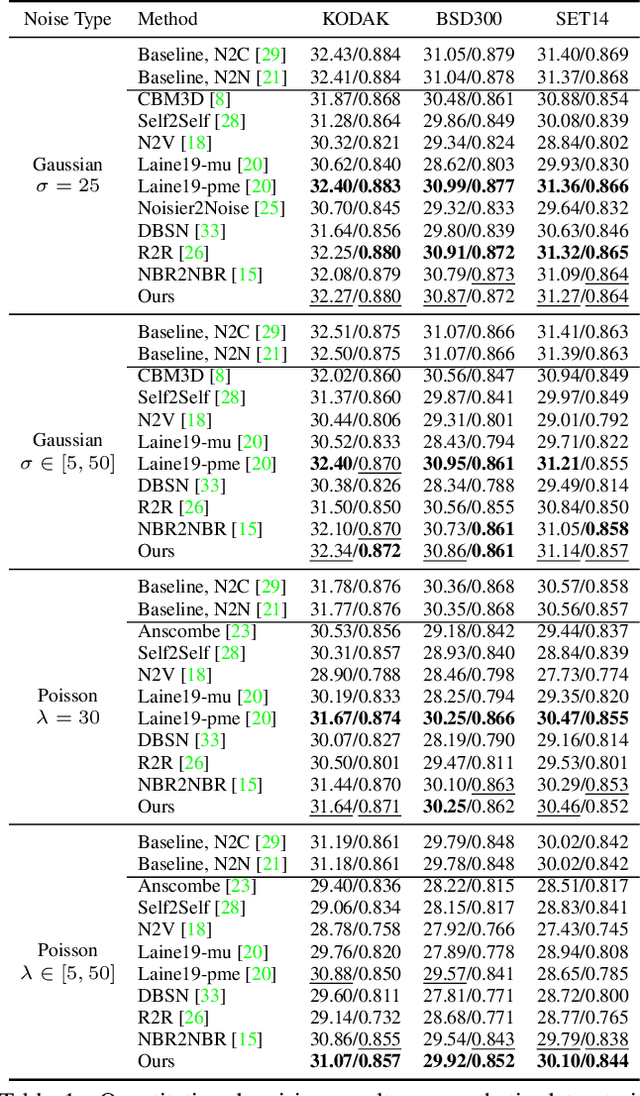
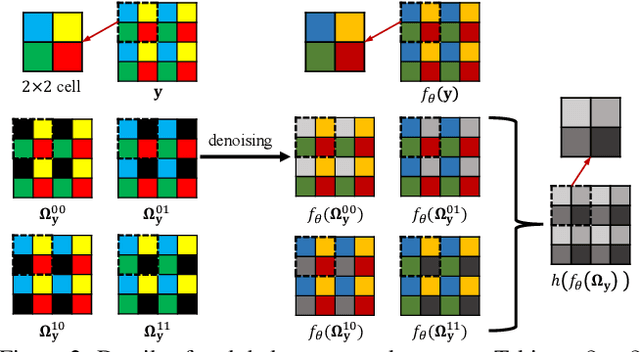
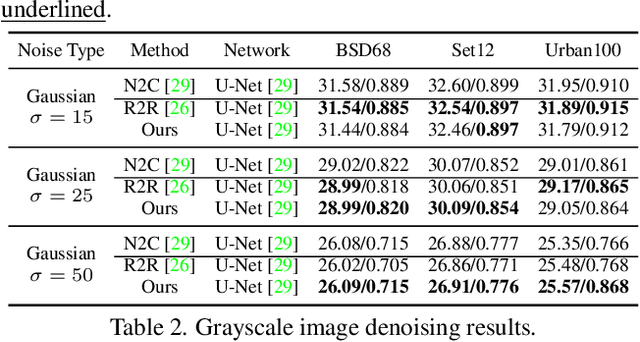
Abstract:Real noisy-clean pairs on a large scale are costly and difficult to obtain. Meanwhile, supervised denoisers trained on synthetic data perform poorly in practice. Self-supervised denoisers, which learn only from single noisy images, solve the data collection problem. However, self-supervised denoising methods, especially blindspot-driven ones, suffer sizable information loss during input or network design. The absence of valuable information dramatically reduces the upper bound of denoising performance. In this paper, we propose a simple yet efficient approach called Blind2Unblind to overcome the information loss in blindspot-driven denoising methods. First, we introduce a global-aware mask mapper that enables global perception and accelerates training. The mask mapper samples all pixels at blind spots on denoised volumes and maps them to the same channel, allowing the loss function to optimize all blind spots at once. Second, we propose a re-visible loss to train the denoising network and make blind spots visible. The denoiser can learn directly from raw noise images without losing information or being trapped in identity mapping. We also theoretically analyze the convergence of the re-visible loss. Extensive experiments on synthetic and real-world datasets demonstrate the superior performance of our approach compared to previous work. Code is available at https://github.com/demonsjin/Blind2Unblind.
Temporal Spatial-Adaptive Interpolation with Deformable Refinement for Electron Microscopic Images
Jan 17, 2021

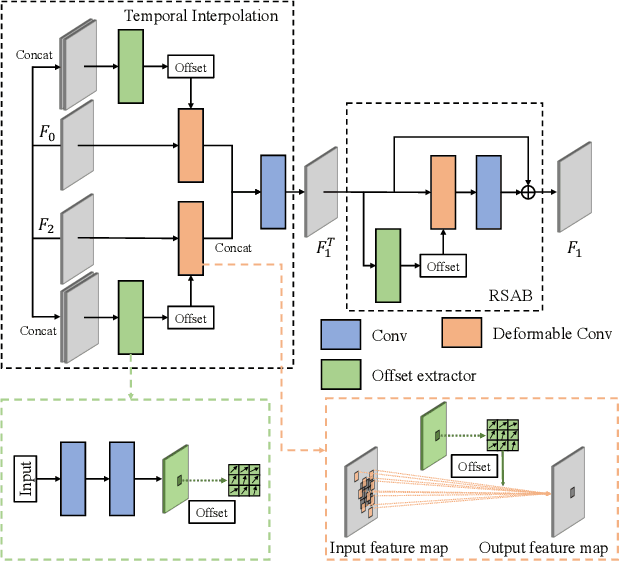

Abstract:Recently, flow-based methods have achieved promising success in video frame interpolation. However, electron microscopic (EM) images suffer from unstable image quality, low PSNR, and disorderly deformation. Existing flow-based interpolation methods cannot precisely compute optical flow for EM images since only predicting each position's unique offset. To overcome these problems, we propose a novel interpolation framework for EM images that progressively synthesizes interpolated features in a coarse-to-fine manner. First, we extract missing intermediate features by the proposed temporal spatial-adaptive (TSA) interpolation module. The TSA interpolation module aggregates temporal contexts and then adaptively samples the spatial-related features with the proposed residual spatial adaptive block. Second, we introduce a stacked deformable refinement block (SDRB) further enhance the reconstruction quality, which is aware of the matching positions and relevant features from input frames with the feedback mechanism. Experimental results demonstrate the superior performance of our approach compared to previous works, both quantitatively and qualitatively.
Non-iterative Simultaneous Rigid Registration Method for Serial Sections of Biological Tissue
May 11, 2020
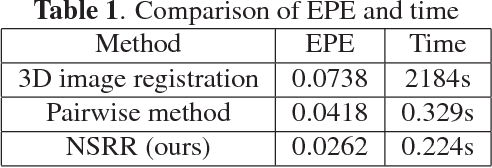
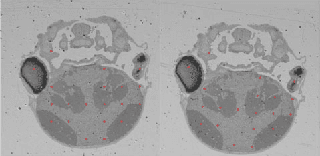
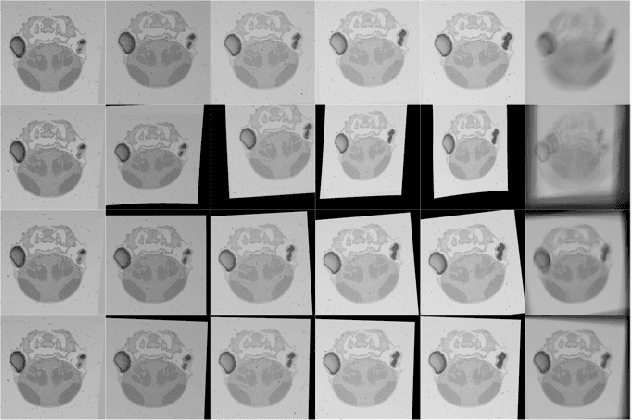
Abstract:In this paper, we propose a novel non-iterative algorithm to simultaneously estimate optimal rigid transformation for serial section images, which is a key component in volume reconstruction of serial sections of biological tissue. In order to avoid error accumulation and propagation caused by current algorithms, we add extra condition that the position of the first and the last section images should remain unchanged. This constrained simultaneous registration problem has not been solved before. Our algorithm method is non-iterative, it can simultaneously compute rigid transformation for a large number of serial section images in a short time. We prove that our algorithm gets optimal solution under ideal condition. And we test our algorithm with synthetic data and real data to verify our algorithm's effectiveness.
* appears in IEEE International Symposium on Biomedical Imaging 2018 (ISBI 2018)
DAN: A Deformation-Aware Network for Consecutive Biomedical Image Interpolation
Apr 23, 2020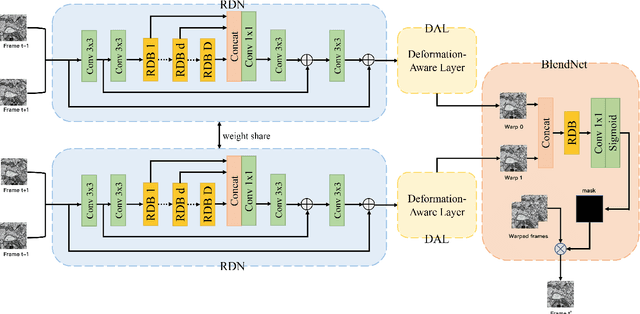



Abstract:The continuity of biological tissue between consecutive biomedical images makes it possible for the video interpolation algorithm, to recover large area defects and tears that are common in biomedical images. However, noise and blur differences, large deformation, and drift between biomedical images, make the task challenging. To address the problem, this paper introduces a deformation-aware network to synthesize each pixel in accordance with the continuity of biological tissue. First, we develop a deformation-aware layer for consecutive biomedical images interpolation that implicitly adopting global perceptual deformation. Second, we present an adaptive style-balance loss to take the style differences of consecutive biomedical images such as blur and noise into consideration. Guided by the deformation-aware module, we synthesize each pixel from a global domain adaptively which further improves the performance of pixel synthesis. Quantitative and qualitative experiments on the benchmark dataset show that the proposed method is superior to the state-of-the-art approaches.
EA-LSTM: Evolutionary Attention-based LSTM for Time Series Prediction
Nov 09, 2018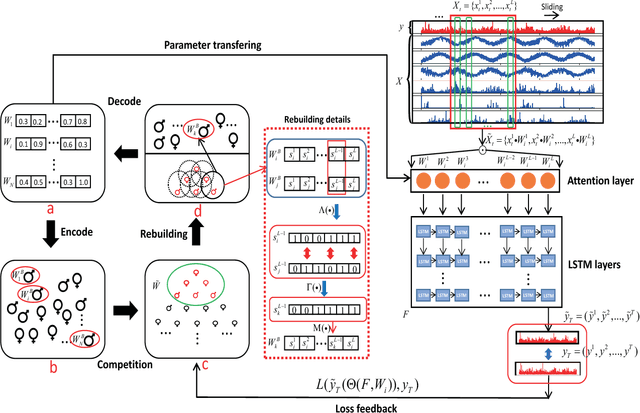



Abstract:Time series prediction with deep learning methods, especially long short-term memory neural networks (LSTMs), have scored significant achievements in recent years. Despite the fact that the LSTMs can help to capture long-term dependencies, its ability to pay different degree of attention on sub-window feature within multiple time-steps is insufficient. To address this issue, an evolutionary attention-based LSTM training with competitive random search is proposed for multivariate time series prediction. By transferring shared parameters, an evolutionary attention learning approach is introduced to the LSTMs model. Thus, like that for biological evolution, the pattern for importance-based attention sampling can be confirmed during temporal relationship mining. To refrain from being trapped into partial optimization like traditional gradient-based methods, an evolutionary computation inspired competitive random search method is proposed, which can well configure the parameters in the attention layer. Experimental results have illustrated that the proposed model can achieve competetive prediction performance compared with other baseline methods.
 Add to Chrome
Add to Chrome Add to Firefox
Add to Firefox Add to Edge
Add to Edge